Modification of Cement Matrix with Complex Additive Based on Chrysotyl Nanofibers and Carbon Black
Abstract
:1. Introduction
2. Materials and Methods
- -
- particle size distribution analysis using the laser dispersion on a SALD-7500nano analyzer manufactured by Shimadzu with the 7 nm to 800 μm measurement range;
- -
- mechanical tests (compressive and flexural strength) on hydraulic press model PGM-100 MG4-A with the maximum load of 100 kN and loading rate of 0.5 MPa per second;
- -
- differential thermal analysis of cement composites on a TGA/DSC1 Star system manufactured by Mettler Toledo in the temperature range from 60 °C to 1100 °C with the heating rate of 30 °C/min;
- -
- IR-spectral analysis of cement composites on Shimadzu IRAffinity-1 spectrometer in the frequency range 400–4000 cm−1;
- -
- microstructure analysis and energy dispersive X-ray analysis (EDX) on scanning electron microscope Quattro ESEM Thermo Fisher Scientific with the resolution up to 0.8 nm.
3. Results and Discussion
4. Conclusions
Author Contributions
Funding
Institutional Review Board Statement
Informed Consent Statement
Data Availability Statement
Conflicts of Interest
References
- Liu, X.; Fang, T.; Zuo, J. Effect of Nano-Materials on Autogenous Shrinkage Properties of Cement Based Materials. Symmetry 2019, 11, 1144. [Google Scholar] [CrossRef] [Green Version]
- Yanagibashi, T.; Kobayashi, M.; Omori, K. Application of Poly-γ-Glutamic Acid Flocculant to Flocculation–Sedimentation Treatment of Ultrafine Cement Suspension. Water 2019, 11, 1748. [Google Scholar] [CrossRef] [Green Version]
- Bumanis, G.; Vitola, L.; Stipniece, L.; Locs, J.; Korjakins, A.; Bajare, D. Evaluation of Industrial by-products as pozzolans: A road map for use in concrete production. Case Stud. Constr. Mater. 2020, 13, e00424. [Google Scholar] [CrossRef]
- Sinka, M.; Zorica, J.; Bajare, D.; Sahmenko, G.; Korjakins, A. Fast Setting Binders for Application in 3D Printing of Bio-Based Building Materials. Sustainability 2020, 12, 8838. [Google Scholar] [CrossRef]
- Samchenko, S.; Kozlova, I.; Zemskova, O.; Potaev, D.; Tsakhilova, D. Efficiency of stabilization of slag suspensions by polycarboxylate. E3S Web Conf. 2019, 91, 02039. [Google Scholar] [CrossRef]
- Ochkurov, V.I.; Vilenskii, M.Y. Comparative evaluation of the saving of binder with fine ground slag. IOP Conf. Ser. Mater. Sci. Eng. 2019, 666, 012026. [Google Scholar] [CrossRef]
- Kazanskaya, L.F.; Isakovsky, V.I.; Fadeeva, S.A. Technological properties of self-compacting concrete mixtures with ground quartz sand. Int. J. Innov. Technol. Explor. Eng. 2019, 8, 799–803. [Google Scholar]
- Belyakov, N.A. Influence of ways of microfiber introduction on the properties of fresh and hardened concrete. Int. J. Civ. Eng. Technol. 2018, 9, 1223–1228. [Google Scholar]
- Petrović, Ž.; Milošević, B.; Ranković, S.; Mladenović, B.; Zlatkov, D.; Zorić, A.; Petronijević, P. Experimental Analysis of Continuous Beams Made of Self-Compacting Concrete (Scc) Strengthened with Fiber Reinforced Polymer (Frp) Materials. Appl. Sci. 2021, 11, 4032. [Google Scholar] [CrossRef]
- Hu, Z.; Li, Q.; Yan, H.; Wen, Y. Experimental Study on Slender CFRP-Confined Circular RC Columns under Axial Compression. Appl. Sci. 2021, 11, 3968. [Google Scholar] [CrossRef]
- Pukharenko, Y.; Staroverov, V.; Ryzhov, D. Nanomodified concrete mixes for form-free moulding. Mater. Today Proc. 2019, 19, 2189–2192. [Google Scholar] [CrossRef]
- Han, B.; Sun, S.; Ding, S.; Zhang, L.; Yu, X.; Ou, J. Review of nanocarbon-engineered multifunctional cementitious composites. Compos. Part A Appl. Sci. Manuf. 2015, 70, 69–81. [Google Scholar] [CrossRef]
- Chernishov, E.; Artamonova, O.; Slavcheva, G. Nano-Modification of Building Composite Structures. Strength Mater. 2020, 2015, 151. [Google Scholar]
- Kozlova, I.; Zemskova, O.; Semenov, V. The Effect of Fine Dispersed Slag Component on the Slag Portland Cement Properties. Mater. Sci. Forum 2020, 1011, 103–108. [Google Scholar] [CrossRef]
- Zheng, W.; Dong, J.; Wen, J.; Chang, C.; Xiao, X. Effects of Water-to-Cement Ratios on the Properties of Magnesium Potassium Phosphate Cement Prepared with Lithium-Extracted Magnesium Residue. Appl. Sci. 2021, 11, 4193. [Google Scholar] [CrossRef]
- Garrault-Gauffinet, S.; Nonat, A. Experimental investigation of calcium silicate hydrate (C-S-H) nucleation. J. Cryst. Growth 1999, 200, 565–574. [Google Scholar] [CrossRef]
- Yang, H.; Cui, H.; Tang, W.; Li, Z.; Han, N.; Xing, F. A critical review on research progress of graphene/cement based composites. Compos. Part Appl. Sci. Manuf. 2017, 102, 273–296. [Google Scholar] [CrossRef]
- Del, C.C.M.; Galao, O.; Baeza, F.J.; Zornoza, E.; Garcés, P. Mechanical Properties and Durability of CNT Cement Composites. Materials 2014, 7, 1640–1651. [Google Scholar]
- Bai, S.Y.; Jiang, L.H.; Xu, N.; Jin, M.; Jiang, S.B. Enhancement of mechanical and electrical properties of graphene/cement composite due to improved dispersion of graphene by addition of silica fume. Constr. Build. Mater. 2018, 164, 433–441. [Google Scholar] [CrossRef]
- Plugin, A.; Iefimenko, A.; Borziak, O.; Gevorkyan, E.; Pluhin, O. Establishing Patterns in the Influence of Micro And Nano-Dispersed Mineral Additives on the Water Resistance of Construction Gypsum. East. Eur. J. Enterp. Technol. 2021, 1, 109. [Google Scholar]
- Bespalov, V.V.; Ucer, D.; Salmanov, I.D.; Kurbanov, I.N.; Kupavykh, S.V. Deformation compatibility of masonry and composite materials. Mag. Civ. Eng. 2018, 2, 136–150. [Google Scholar]
- Alexeev, A.I.; Zubkova, O.S.; Vasilyev, V.V.; Kurtenkov, R.V. Pit sump drainage thickening to remove saponite rock suspension. Obogashchenie Rud 2020, 2020, 35–40. [Google Scholar] [CrossRef]
- Kostyuk, T.; Vinnichenko, V.; Borziak, O.; Iefimenko, A. Physicochemical studies of the structure of energy-saving compositions based on slags. In IOP Conference Series: Materials Science and Engineering; IOP Publishing: Bristol, UK, 2021; Volume 1021, p. 012016. [Google Scholar]
- Ibragimov, R.A.; Korolev, E.V.; Deberdeev, T.R. Mechanical activation in the production of lime-sand mixtures. Mag. Civ. Eng. 2020, 6, 9804. [Google Scholar]
- Teng, S.; Lim TY, D.; Sabet, D.B. Durability and mechanical properties of high strength concrete incorporating ultrafine ground granulated blast-furnace slag. Constr. Build. Mater. 2013, 40, 875–881. [Google Scholar] [CrossRef]
- Karapetian, K.; Dzhevaga, N. Modern technologies of complex processing of phosphates. ARPN J. Eng. Appl. Sci. 2017, 12, 4588–4594. [Google Scholar]
- Chernyshov, S.E.; Galkin, V.I.; Ulyanova, Z.V. Macdonald David Iain Macpherson. Development of mathematical models to control the technological properties of cement slurries. J. Min. Inst. 2020, 242, 179–190. [Google Scholar] [CrossRef]
- Tan, H.; Li, M.; He, X.; Su, Y.; Yang, J.; Zhao, H. Effect of wet grinded lithium slag on compressive strength and hydration of sulphoaluminate cement system. Constr. Build. Mater. 2021, 267, 120465. [Google Scholar] [CrossRef]
- Naumova, L.N.; Pavlenko, V.I.; Cherkashina, N.I. Modification of chrysotile fiber surface and its effect on the physical and mechanical characteristics of chrysotile cement. Prot. Met. Phys. Chem. Surf. 2019, 55, 330–334. [Google Scholar] [CrossRef]
- Kim, T.; Naoki, W.; Miyawaki, J.; Park, J.I.; Lee, C.; Jung, H.K.; Yoon, S.H. Synthesis of surface-replicated ultra-thin silica hollow nanofibers using structurally different carbon nanofibers as templates. J. Solid State Chem. 2019, 272, 21–26. [Google Scholar] [CrossRef]
- Yakovlev, G.; Vít, Č.; Polyanskikh, I.; Gordina, A.; Pudov, I.; Gumenyuk, A.; Smirnova, O. The Effect of Complex Modification on the Impedance of Cement Matrices. Materials 2021, 14, 557. [Google Scholar] [CrossRef]
- Nikolayev, N.I.; Kovalchuk, V.S. Analysis of effect of carbon black on plugging mixtures. In Journal of Physics: Conference Series; IOP Publishing: Bristol, UK, 2020; Volume 1679. [Google Scholar] [CrossRef]
- Yakovlev, G.; Grakhov, V.; Polyanskih, I.; Gordina, A.; Pudov, I.; Mohhamed, A.; Saidova, Z. Dispersion Degree and its Influence on Structure of Building Materials. IOP Conf. Ser. Mater. Sci. Eng. 2019, 471, 032003. [Google Scholar] [CrossRef]
- Stynoski, P.; Mondal, P.; Wotring, E.; Marsh, C. Characterization of silica-functionalized carbon nanotubes dispersed in water. J. Nanoparticle Res. 2013, 15, 1–10. [Google Scholar] [CrossRef]
- Kovalchuk, V.S.; Nikolaev, N.I. Carbon additives for high-quality well cementing. IOP Conf. Ser. Earth Environ. Sci. 2021, 677, 052035. [Google Scholar] [CrossRef]
- Accardo, G.; Cioffi, R.; Colangelo, F.; d’Angelo, R.; De Stefano, L.; Paglietti, F. Diffuse reflectance infrared fourier transform spectroscopy for the determination of asbestos species in bulk building materials. Materials 2014, 7, 457–470. [Google Scholar] [CrossRef] [PubMed] [Green Version]
- Pavlenko, A.; Mishakova, A.; Pertseva, O.; Ivanova, V.; Olekhnovich, Y.; Averchenko, G. Feasibility of using of accelerated test methods for determination of frost-resistance for concrete. E3S Web Conf. 2020, 157, 06035. [Google Scholar] [CrossRef] [Green Version]
- Rabahi-Touloum, N.; Brara, A. The occurrence of thaumasite in newly built concrete constructions under the semi-arid climate of Northeastern Algeria. Mater. Struct. 2021, 54, 1–17. [Google Scholar] [CrossRef]
- Mirvalad, S.; Nokken, M.; Banu, D. Detection of thaumasite formation using differential scanning calorimetry. J. Mater. Civ. Eng. 2019, 31, 04019178. [Google Scholar] [CrossRef]




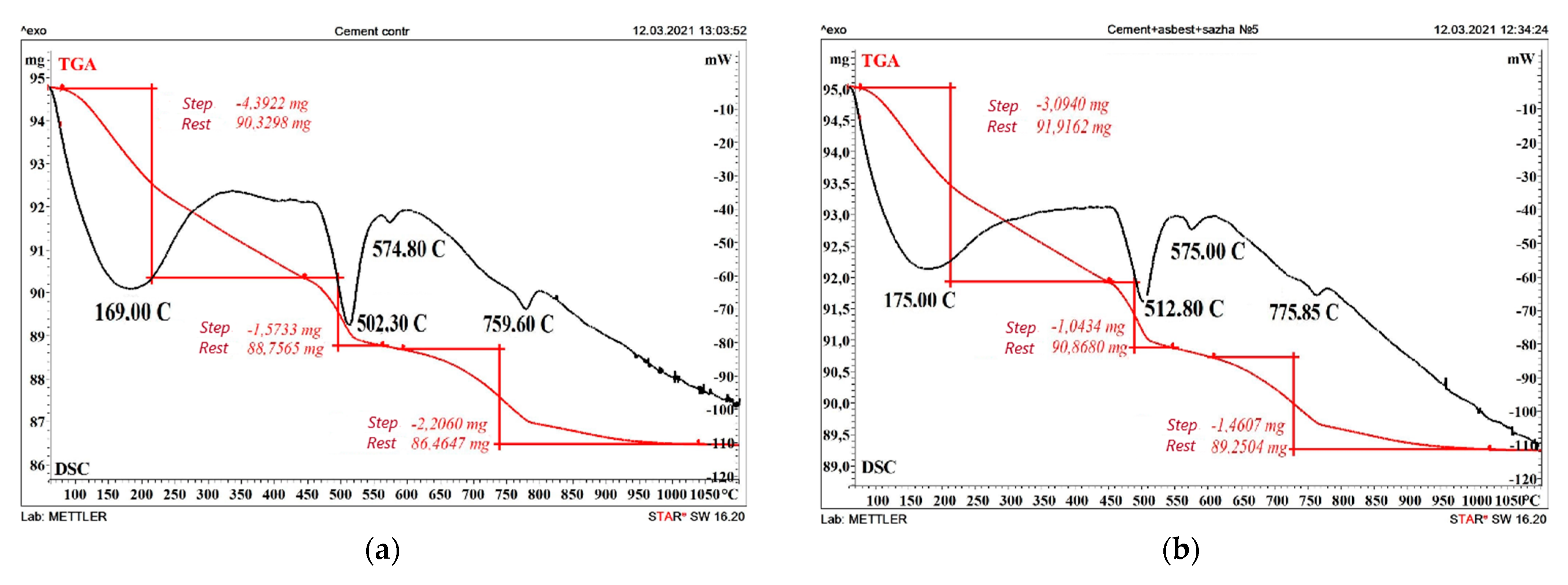
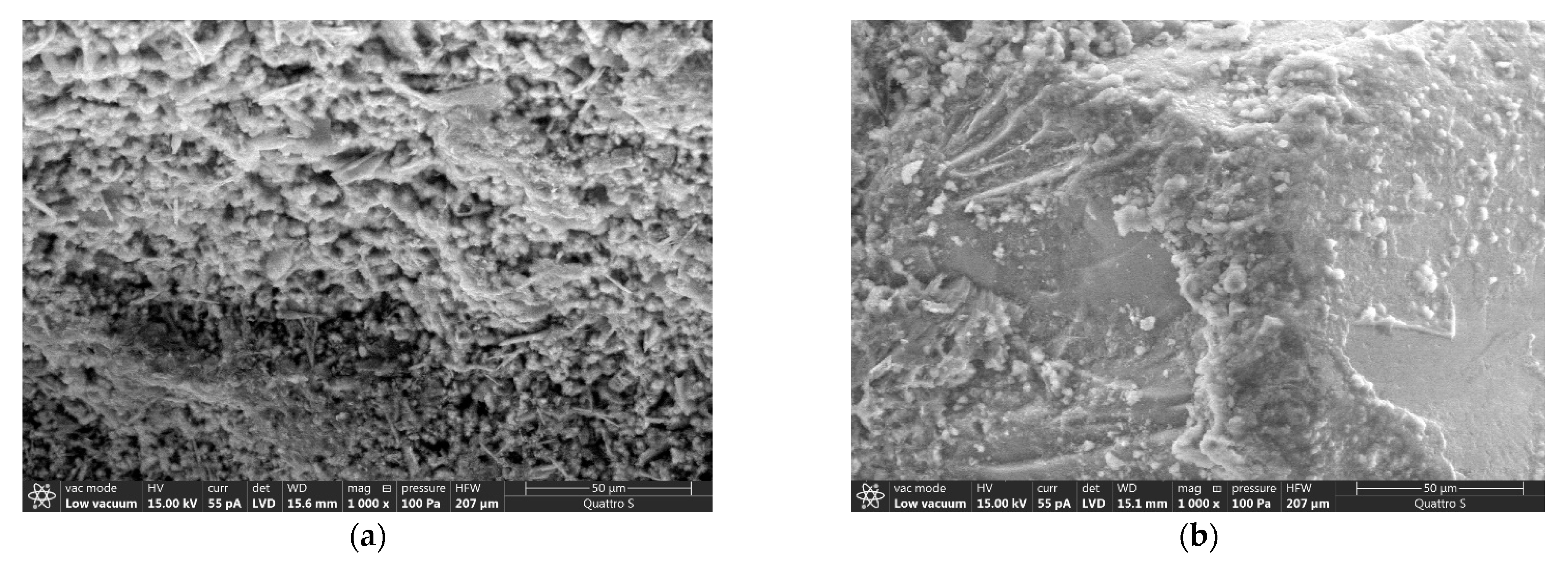
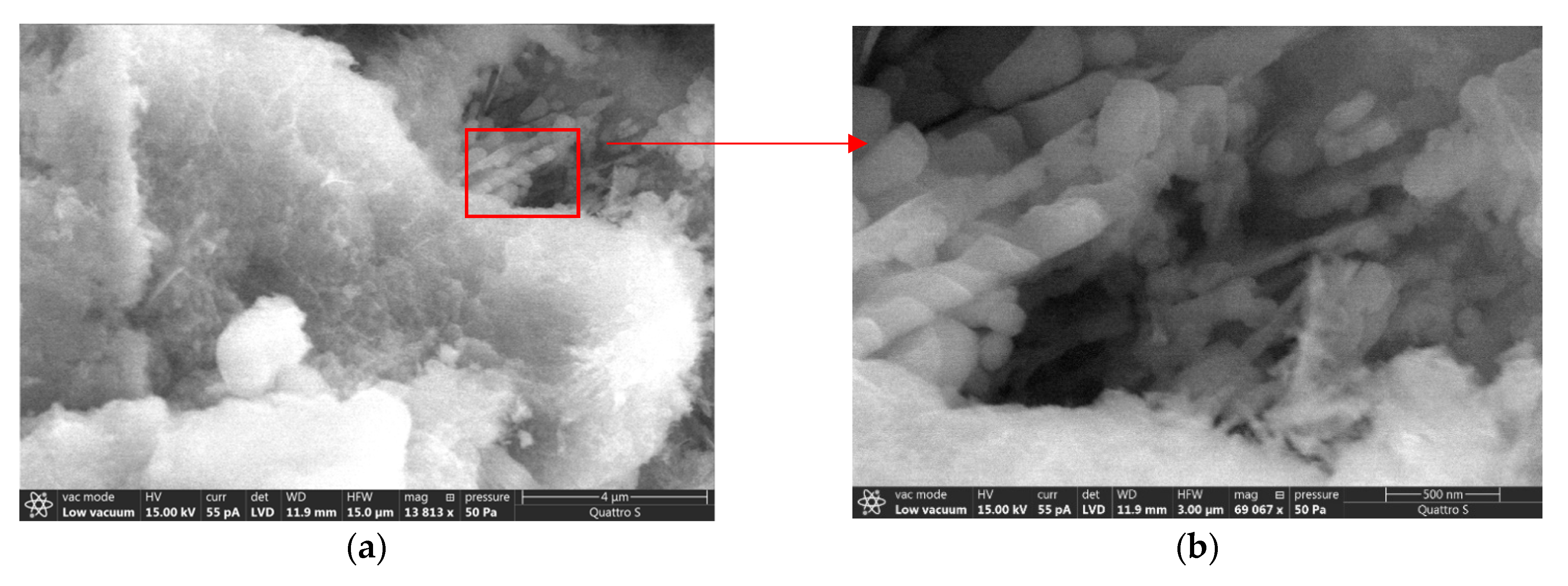

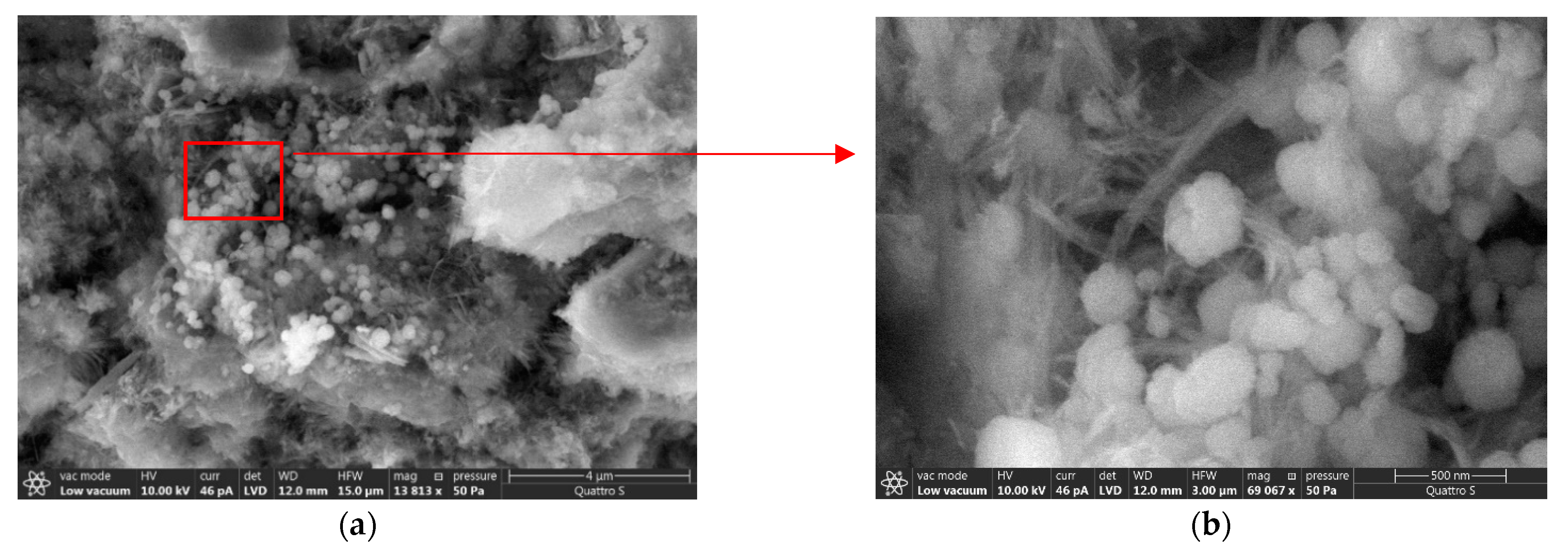
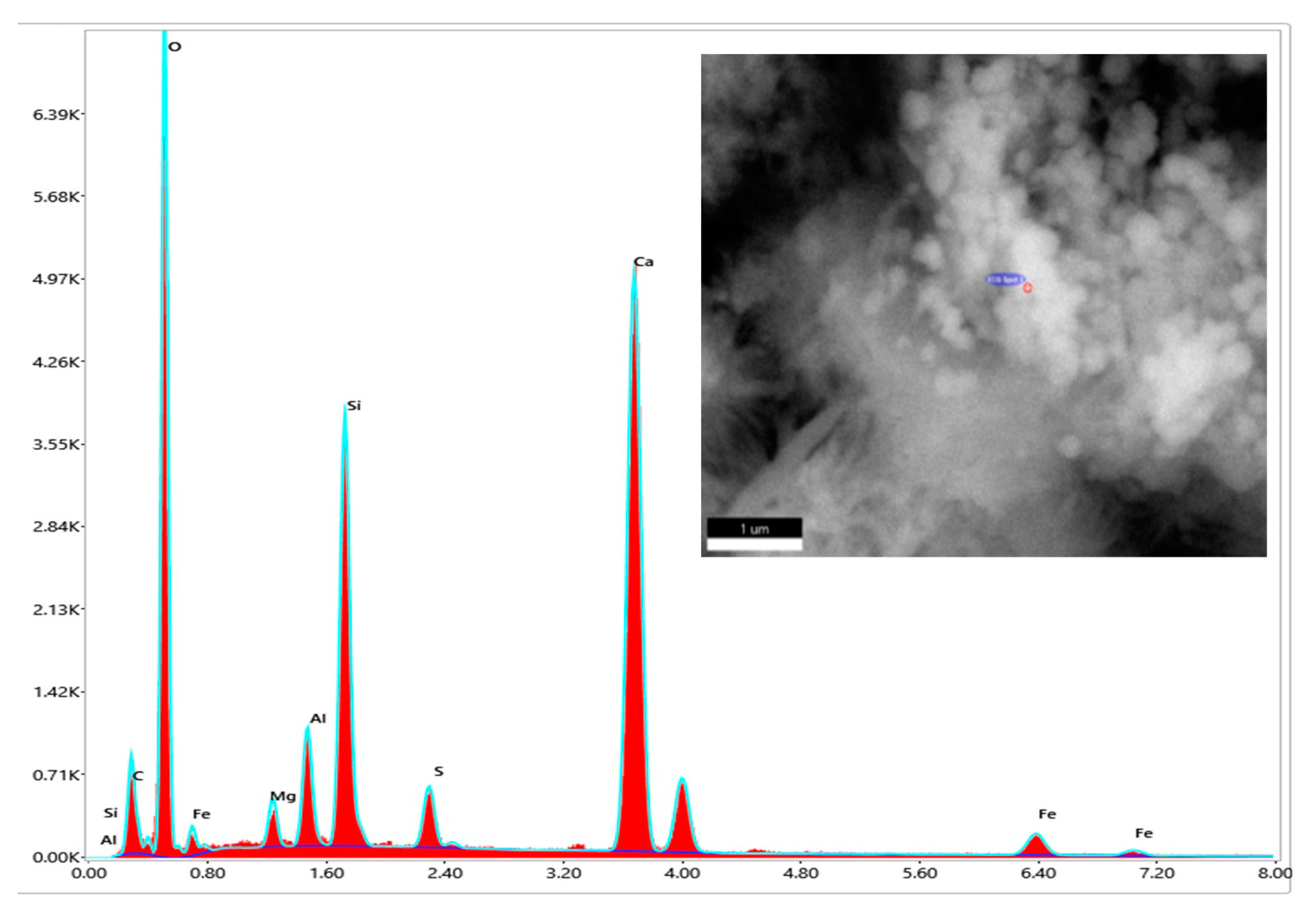
| Chrysotile Amount, % | Compressive Strength, MPa | Flexural Strength, MPa | ||||||||||
|---|---|---|---|---|---|---|---|---|---|---|---|---|
| Carbon Black Amount, % | Carbon Black Amount, % | |||||||||||
| 0 | 0.005 | 0.01 | 0.02 | 0.05 | 0.1 | 0 | 0.005 | 0.01 | 0.02 | 0.05 | 0.1 | |
| 0 | 27.6 | 30.7 | 29.9 | 30.3 | 27.8 | 27.4 | 4.39 | 4.45 | 4.76 | 4.82 | 4.42 | 4.51 |
| 0.01 | 28.2 | 31.0 | 30.7 | 30.8 | 31.5 | 30.1 | 4.84 | 4.73 | 4.72 | 4.90 | 4.87 | 4.79 |
| 0.025 | 29.7 | 31.3 | 31.4 | 32.8 | 31.5 | 30.2 | 4.79 | 4.98 | 4.87 | 5.22 | 4.98 | 4.80 |
| 0.05 | 32.3 | 34.2 | 36.4 | 35.4 | 33.2 | 30.0 | 4.58 | 5.12 | 5.56 | 5.48 | 5.29 | 4.77 |
| 0.075 | 30.9 | 34.6 | 33.9 | 33.1 | 32.3 | 28.7 | 4.57 | 4.91 | 5.17 | 5.11 | 4.84 | 4.56 |
| 0.1 | 29.7 | 30.9 | 30.2 | 29.9 | 28.3 | 28.2 | 4.51 | 4.60 | 4.42 | 4.58 | 4.42 | 4.41 |
Publisher’s Note: MDPI stays neutral with regard to jurisdictional claims in published maps and institutional affiliations. |
© 2021 by the authors. Licensee MDPI, Basel, Switzerland. This article is an open access article distributed under the terms and conditions of the Creative Commons Attribution (CC BY) license (https://creativecommons.org/licenses/by/4.0/).
Share and Cite
Saidova, Z.; Yakovlev, G.; Smirnova, O.; Gordina, A.; Kuzmina, N. Modification of Cement Matrix with Complex Additive Based on Chrysotyl Nanofibers and Carbon Black. Appl. Sci. 2021, 11, 6943. https://doi.org/10.3390/app11156943
Saidova Z, Yakovlev G, Smirnova O, Gordina A, Kuzmina N. Modification of Cement Matrix with Complex Additive Based on Chrysotyl Nanofibers and Carbon Black. Applied Sciences. 2021; 11(15):6943. https://doi.org/10.3390/app11156943
Chicago/Turabian StyleSaidova, Zarina, Grigory Yakovlev, Olga Smirnova, Anastasiya Gordina, and Natalia Kuzmina. 2021. "Modification of Cement Matrix with Complex Additive Based on Chrysotyl Nanofibers and Carbon Black" Applied Sciences 11, no. 15: 6943. https://doi.org/10.3390/app11156943
APA StyleSaidova, Z., Yakovlev, G., Smirnova, O., Gordina, A., & Kuzmina, N. (2021). Modification of Cement Matrix with Complex Additive Based on Chrysotyl Nanofibers and Carbon Black. Applied Sciences, 11(15), 6943. https://doi.org/10.3390/app11156943







